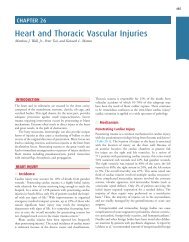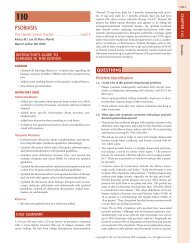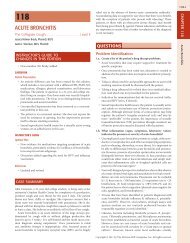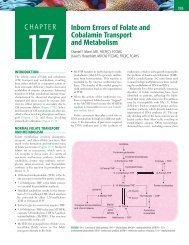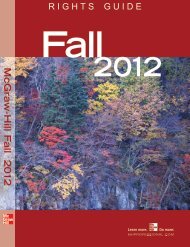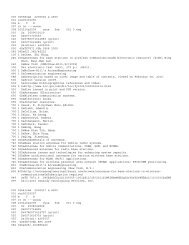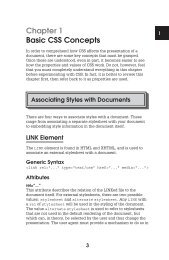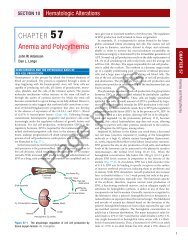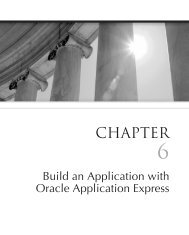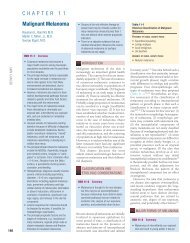Free Pre-Test with Answers - McGraw-Hill Professional
Free Pre-Test with Answers - McGraw-Hill Professional
Free Pre-Test with Answers - McGraw-Hill Professional
You also want an ePaper? Increase the reach of your titles
YUMPU automatically turns print PDFs into web optimized ePapers that Google loves.
How Ready Are You?<br />
The Questions<br />
Self-Assessment<br />
<strong>Test</strong><br />
— by Michael Jang<br />
This self-assessment test features a series of fill-in-the-blank questions designed to<br />
help you assess your readiness for the Red Hat Certified Systems Administrator<br />
(RHCSA) and Red Hat Certified Engineer (RHCE) exams. The results of this test<br />
will gauge your level of mastery of the exam objectives and provide recommended<br />
courses of study based on your performance.<br />
The self-assessment questions are based on the outlines for the three Red Hat<br />
courses associated <strong>with</strong> the RHCSA and RHCE certifications: Red Hat System<br />
Administration I, II, and III (RH124, RH135, and RH255). For the latest outlines<br />
on these courses, see www.redhat.com/training/courses/. The questions are also based<br />
on the latest RHCSA and RHCE exam objectives. For the latest version of the exam<br />
objectives, see www.redhat.com/training/courses/ex200/examobjective and www<br />
.redhat.com/training/courses/ex300/examobjective.<br />
As you will see, the questions are divided into three categories: basic, intermediate,<br />
and advanced administration. The questions included in the basic section provide one<br />
way to measure your knowledge of the information associated <strong>with</strong> Red Hat’s introductory<br />
course (System Administration I). Many of the topics in this course are functional<br />
prerequisites for the Red Hat certifications. The questions included in the intermediate<br />
and advanced sections are associated <strong>with</strong> the RHCSA and RHCE exam objectives.<br />
Copyright © 2013 by The <strong>McGraw</strong>-<strong>Hill</strong> Companies
2<br />
RHCSA/RHCE Red Hat Linux Certifi cation Practice Exams <strong>with</strong> Virtual Machines<br />
Considerations for the Self-Assessment <strong>Test</strong><br />
Questions<br />
Basic Administration<br />
The official Red Hat exams are hands-on exams. As these self-assessment questions<br />
are fill-in-the-blank questions they’re subject to interpretation. You need to make<br />
your own judgment as to whether you’ve answered a question correctly and whether<br />
you feel that you’ve mastered the associated topics. There is nothing “scientific”<br />
about any of the questions that I’ve created. These are questions that I’ve created<br />
based on my experience authoring exam prep guides for the Red Hat exams for the<br />
last ten years.<br />
Some of the answers may seem impossible; if you know how to look up the answer<br />
quickly, and I emphasize, quickly under time pressure, <strong>with</strong>out access to books or the<br />
Internet, that is probably acceptable. For example, you may be able to look up<br />
commands <strong>with</strong> the help of the documentation available on a Red Hat system. All<br />
of the questions assume that you know how to log into a RHEL 6 system. In many<br />
cases, multiple answers are acceptable; if you know multiple answers to these questions<br />
that’s an excellent indicator of your readiness.<br />
Anyone can get lucky, even when answering fill-in-the-blank questions. Be<br />
honest <strong>with</strong> yourself. Know your strengths associated <strong>with</strong> each topic. It’s up to you<br />
to determine what to study. Good luck!<br />
The questions have been split into three sections. They’re loosely associated <strong>with</strong><br />
the published outline for the three Red Hat courses noted, RH124, RH135, and<br />
RH255, respectively.<br />
1. What dedicated text editor can you use from the graphical interface?<br />
_____________________________________________________________<br />
2. What is the name of the RHEL 6 graphical file browser?<br />
_____________________________________________________________<br />
3. Name three different types of help systems in Linux.<br />
_________________ ____________________ __________________<br />
Copyright © 2013 by The <strong>McGraw</strong>-<strong>Hill</strong> Companies
Self-Assessment <strong>Test</strong> 3<br />
4. What tool can you use to configure a system to synchronize its time <strong>with</strong> a<br />
Network Time Protocol Server?<br />
_____________________________________________________________<br />
5. What tool can you use to configure a printer?<br />
_____________________________________________________________<br />
6. Name three different Linux partition types that you can configure.<br />
_____________ _________________________ ______________________<br />
7. Name a utility that can measure the current load on the CPU and RAM<br />
memory.<br />
_____________________________________________________________<br />
8. What command or utility can be used to update the current software on the<br />
system?<br />
_____________________________________________________________<br />
9. List the commands that you can use to copy, move, delete, and create files.<br />
___________ ___________________ _____________ _________________<br />
10. Name two different commands associated <strong>with</strong> command manuals.<br />
______________________________ _______________________________<br />
11. What file normally governs the configuration of the first Ethernet card on a<br />
system?<br />
_____________________________________________________________<br />
12. Name two commands associated <strong>with</strong> testing network connectivity.<br />
____________________________ _________________________________<br />
13. What four files are associated <strong>with</strong> the configuration of users and groups?<br />
_____________________________________________________________<br />
14. Based on the typical output from the ls -l command, such as the following,<br />
name the user and group owner, and describe the permissions given to the<br />
user owner, the group owner, and all other users:<br />
-rw-r----x. 1 jb123 am456 2395 Apr 23 23:11 def<br />
_____________________________________________________________<br />
Copyright © 2013 by The <strong>McGraw</strong>-<strong>Hill</strong> Companies
4<br />
RHCSA/RHCE Red Hat Linux Certifi cation Practice Exams <strong>with</strong> Virtual Machines<br />
15. Enter the secure shell command that would connect to user jim’s account<br />
on the remote system named testing in a way that supports access to remote<br />
graphical applications.<br />
_____________________________________________________________<br />
16. What directory includes most of the scripts that control Linux services?<br />
Name three commands that you can use <strong>with</strong> most of those scripts.<br />
__________ _________________ ___________________ ______________<br />
17. If you’ve configured a /dev/sda5 partition as swap space, what command<br />
would you use to format it? What entry would work for that swap space in<br />
/etc/fstab?<br />
_____________________________________________________________<br />
_____________________________________________________________<br />
18. What is the GUI tool that can help manage virtual machines?<br />
____________________________ _________________________________<br />
19. What command can you use to create an encrypted password for GRUB?<br />
_____________________________________________________________<br />
20. What command compresses the /home directory into an archive in bzip2<br />
format, in a file named homearch.tar.bz2?<br />
_____________________________________________________________<br />
21. Enter a command that lists all users who use bash as their default shells.<br />
_____________________________________________________________<br />
22. For a default RHEL 6 installation, what runlevel is associated <strong>with</strong> the GUI?<br />
_____________________________________________________________<br />
23. Enter a command that creates a /home/testuser/smb.conf file soft-linked to<br />
the /etc/samba/smb.conf file.<br />
_____________________________________________________________<br />
24. What console is associated <strong>with</strong> the GUI in a default installation of RHEL 6?<br />
_____________________________________________________________<br />
Copyright © 2013 by The <strong>McGraw</strong>-<strong>Hill</strong> Companies
Intermediate Administration<br />
Self-Assessment <strong>Test</strong> 5<br />
25. What utility can you use to allow access to standard services through the<br />
firewall?<br />
_____________________________________________________________<br />
26. What package is associated <strong>with</strong> the RHEL FTP server, and where are data<br />
files for that server normally stored?<br />
_____________________________________________________________<br />
27. What command lists the SELinux contexts of the files in the current<br />
directory?<br />
_____________________________________________________________<br />
28. Where is the Kickstart configuration file template for a system? Several<br />
directives are typically commented out in that file. What kind of directives<br />
are these?<br />
___________________________ _________________________________<br />
29. What command displays the current numeric network routing table?<br />
_____________________________________________________________<br />
30. What command would prepare a partition for encryption? What command<br />
would actually encrypt that partition, prompting for a passphrase?<br />
_____________________________ _______________________________<br />
31. Based on a logical volume configured in /dev/mapper/vg00-lv00, formatted<br />
to ext4, what would you enter in /etc/fstab to configure the /abc directory on<br />
that volume?<br />
_____________________________________________________________<br />
32. What command would you use to mount a directory named /home2, shared<br />
via NFSv4, from a server named whitehat, and on a local directory named<br />
/remote?<br />
_____________________________________________________________<br />
33. What command would list the current password-aging parameters associated<br />
<strong>with</strong> user mike?<br />
_____________________________________________________________<br />
Copyright © 2013 by The <strong>McGraw</strong>-<strong>Hill</strong> Companies
6<br />
RHCSA/RHCE Red Hat Linux Certifi cation Practice Exams <strong>with</strong> Virtual Machines<br />
34. For an LDAP client, what would be the Distinguished Name associated <strong>with</strong><br />
the example.org network?<br />
_____________________________________________________________<br />
35. What command adds the set-GID bit on the /home/shared directory?<br />
_____________________________________________________________<br />
36. What command would give user elizabeth (and only that user) read and write<br />
permissions on the file named secret.txt, owned by user mike and group mike,<br />
and in the /home/mike directory?<br />
_____________________________________________________________<br />
37. What command would set the same SELinux file contexts on the /ftpserver<br />
directory as those on the /var/ftp directory?<br />
_____________________________________________________________<br />
38. What command would activate the ftp_home_dir SELinux boolean in a way<br />
that would survive a reboot?<br />
_____________________________________________________________<br />
39. What yum command lists all available package groups?<br />
_____________________________________________________________<br />
40. What command configures the httpd service to start in runlevels 2, 3, 4,<br />
and 5?<br />
_____________________________________________________________<br />
41. What configuration file includes help on how to set up a cron job?<br />
_____________________________________________________________<br />
42. What command lists the runlevel status of all services controlled by scripts in<br />
the /etc/init.d directory?<br />
_____________________________________________________________<br />
43. Explain the relationship among Physical Volumes, Volume Groups, and<br />
Logical Volumes.<br />
_____________________________________________________________<br />
_____________________________________________________________<br />
_____________________________________________________________<br />
Copyright © 2013 by The <strong>McGraw</strong>-<strong>Hill</strong> Companies
Self-Assessment <strong>Test</strong> 7<br />
44. What would you add to the /etc/fstab file to make sure a file system is<br />
mounted to support Access Control Lists the next time the system is booted?<br />
_____________________________________________________________<br />
45. What command can be used to control and configure the operation of KVMbased<br />
virtual machines?<br />
_____________________________________________________________<br />
46. Enter the command that restores the default SELinux file contexts on the<br />
/var/ftp directory.<br />
_____________________________________________________________<br />
47. Name the directory where SELinux booleans are stored.<br />
_____________________________________________________________<br />
48. Name a tool or a command that you can use to resize a logical volume, and<br />
how that relates to the size of the formatted file system.<br />
_____________________________________________________________<br />
Advanced Administration<br />
49. What is the port number associated <strong>with</strong> remote system logging?<br />
___________________________________________________________________<br />
50. What is the file used to configure administrative privileges for regular users?<br />
What command is used to access that file?<br />
_______________________________ ____________________________________<br />
51. What line(s) would you add to a simple script that lists the current<br />
nonhidden files in the /etc directory and writes those filenames to the<br />
/tmp/config.txt file.<br />
_____________________________________________________________<br />
52. What command can you use to build existing source code into an RPM based<br />
on a properly configured spec file? While no switches are required, knowing<br />
the switches can help demonstrate your mastery of this topic.<br />
_____________________________________________________________<br />
Copyright © 2013 by The <strong>McGraw</strong>-<strong>Hill</strong> Companies
8<br />
RHCSA/RHCE Red Hat Linux Certifi cation Practice Exams <strong>with</strong> Virtual Machines<br />
53. What is the name of the main NTP configuration file? What directive can<br />
you add to that file to point to a different NTP server? It would be great if you<br />
know both answers.<br />
_________________________ ___________________________________<br />
54. What command is used to discover available iSCSI targets for network<br />
storage?<br />
_____________________________________________________________<br />
55. You know that IPv4 forwarding is configured in the /proc/sys/net/ipv4/<br />
ip_forward file. What directive would you add to the /etc/sysctl.conf file to<br />
implement IPv4 forwarding on a permanent basis?<br />
_____________________________________________________________<br />
56. What directive in the SSH configuration file specifies the access port?<br />
_____________________________________________________________<br />
57. What command creates a private/public keypair for SSH connections?<br />
_____________________________________________________________<br />
58. For user rajiv, in what directory would you find SSH private and public keys?<br />
_____________________________________________________________<br />
59. What command, when run in the /etc/pki/tls/certs directory, creates selfsigned<br />
certificates for a web site named success.example.org?<br />
_____________________________________________________________<br />
60. In the main Apache configuration file, what directive would you activate to<br />
enable name-based virtual hosting?<br />
_____________________________________________________________<br />
61. What directive can you add to the Apache configuration file to support the<br />
execution of CGI scripts such as those written in Perl?<br />
_____________________________________________________________<br />
62. What is the file that contains the default configuration for a secure HTTP<br />
web site?<br />
_____________________________________________________________<br />
Copyright © 2013 by The <strong>McGraw</strong>-<strong>Hill</strong> Companies
Self-Assessment <strong>Test</strong> 9<br />
63. In what directory can you find the configuration files for the default server<br />
associated <strong>with</strong> the Simple Mail Transfer Protocol (SMTP)?<br />
_____________________________________________________________<br />
64. What configuration file is used to configure account aliases for both RHEL 6<br />
SMTP services (Postfix and sendmail)?<br />
_____________________________________________________________<br />
65. What command confirms the status of a DNS server when it’s operational?<br />
_____________________________________________________________<br />
66. What is the communication port number associated <strong>with</strong> DNS?<br />
_____________________________________________________________<br />
67. What would you enter in an /etc/exports file when you want to share an<br />
/admin directory in read-only mode <strong>with</strong> systems on the 192.168.0.0/24<br />
network, allowing root users who connect to have full privileges? (Yes, that’s<br />
a highly insecure option.)<br />
_____________________________________________________________<br />
68. What command actually implements exported NFS directories, <strong>with</strong>out<br />
restarting the service?<br />
_____________________________________________________________<br />
69. What command adds user meghan to the default Samba password database?<br />
Assume meghan also has a regular account on the Samba server system.<br />
_____________________________________________________________<br />
70. What SELinux boolean do you need to activate before sharing user home<br />
directories via Samba?<br />
_____________________________________________________________<br />
71. What directive in the Red Hat FTP configuration file would you disable to<br />
set up an anonymous-only FTP server?<br />
_____________________________________________________________<br />
72. What is the name of the tool that can help you to configure a system as a<br />
Kerberos client?<br />
_____________________________________________________________<br />
Copyright © 2013 by The <strong>McGraw</strong>-<strong>Hill</strong> Companies
10<br />
RHCSA/RHCE Red Hat Linux Certifi cation Practice Exams <strong>with</strong> Virtual Machines<br />
<strong>Answers</strong><br />
Basic Administration<br />
1. The standard “dedicated” text editor associated <strong>with</strong> the RHEL 6 graphical<br />
interface is gEdit. However, Linux includes many other text editors, including<br />
vi, emacs, nano, and so on. Any of these answers are acceptable. However,<br />
one answer that I would be concerned about is any standard graphical word<br />
processor such as OpenOffice.org Writer. Although you can save files from<br />
that application in text format, it is not known as a text editor.<br />
2. The standard RHEL 6 graphical file browser is nautilus. However, there are<br />
other graphical (and console-based) file browsers available, such as Konqueror<br />
and midnight commander.<br />
3. The question is intentionally vague and is intended to make you think about<br />
the help systems that are available <strong>with</strong> Linux. The standard help systems<br />
associated <strong>with</strong> RHEL 6 include man pages, info manuals, as well as the<br />
GNOME help browser available in the GUI from the System menu.<br />
4. The name of the GUI tool that can help you configure a system to synchronize<br />
its time <strong>with</strong> an NTP server is the Date/Time Properties tool. You can<br />
start it <strong>with</strong> the system-config-date command. (It is no longer linked to<br />
the system-config-time command.) If you just want to synchronize a system<br />
from the command line, you could delete the /etc/ntp.conf file and configure<br />
remote servers in the /etc/ntp/step-tickers file. Of course, you can directly<br />
configure such servers in the /etc/ntp.conf file.<br />
5. The standard RHEL 6 tool for configuring printers is the Printer Configuration<br />
tool, available <strong>with</strong> the system-config-printer command. Of course, you<br />
can use the web-based tool associated <strong>with</strong> the default RHEL 6 print service.<br />
When active, point a web browser to http://localhost:631 to access that tool.<br />
Naturally, you can configure printers directly in the configuration files of the<br />
/etc/cups directory. But that is a complex process, not covered in either the<br />
RHCSA or RHCE objectives.<br />
6. As shown in fdisk utility, there are at least six different partition types<br />
directly associated <strong>with</strong> Linux. The four that are most commonly used are<br />
Linux, Linux swap, Linux LVM, and Linux raid auto. These partition types<br />
Copyright © 2013 by The <strong>McGraw</strong>-<strong>Hill</strong> Companies
Self-Assessment <strong>Test</strong> 11<br />
go by slightly different names in the parted utility. If you can recognize those<br />
names, that’s a good sign.<br />
7. The top utility is the standard way to measure the current load on CPU and<br />
RAM. The free command can measure the load on RAM.<br />
8. The yum update command may be the most straightforward way to update<br />
the current software on an RHEL system. The GUI Software Update tool,<br />
which you can start <strong>with</strong> the gpk-update-viewer command, can also be used<br />
to update current software. Those of you who know the Red Hat Network<br />
know that can also be used to push updated software onto clients that may<br />
need it.<br />
9. The straightforward answer to this question is that the copy command is cp;<br />
the move command is mv; the delete command is rm; and the touch command<br />
can be used to create files.<br />
10. This question is different from question 3, in that it relates to the command<br />
manual system. The man -k searchterm command is equivalent to apropos<br />
searchterm, which searches the command manual database for the specified<br />
searchterm.<br />
11. The standard configuration file associated <strong>with</strong> the first Ethernet adapter is<br />
ifcfg-eth0, normally stored in the /etc/sysconfig/network-scripts directory.<br />
12. Two commands associated <strong>with</strong> testing network connectivity are ping and<br />
traceroute. Although they go beyond testing network connectivity, the nmap<br />
and telnet commands can be used to test connectivity in different ways.<br />
13. The files associated <strong>with</strong> the configuration of the users and groups is known<br />
as the Shadow Password Suite; those files are /etc/passwd, /etc/group,<br />
/etc/shadow, and /etc/gshadow.<br />
14. The file is def, <strong>with</strong> a user owner of jb123 <strong>with</strong> read-write permissions and<br />
a group owner of am456 <strong>with</strong> read-only permissions. All other users have<br />
execute-only permissions.<br />
15. The ssh -l jim testing command connects to user jim’s account on the system<br />
named testing. The ssh jim@testing command is functionally equivalent.<br />
16. The /etc/rc.d/init.d directory includes most of the scripts that control Linux<br />
services. It is linked to the /etc/init.d directory, which is, therefore, also an<br />
acceptable answer. These scripts normally work <strong>with</strong> at least the stop, start,<br />
and restart commands. Many also work <strong>with</strong> commands like reload and<br />
status, which are also acceptable answers. Other commands like condrestart<br />
Copyright © 2013 by The <strong>McGraw</strong>-<strong>Hill</strong> Companies
12<br />
RHCSA/RHCE Red Hat Linux Certifi cation Practice Exams <strong>with</strong> Virtual Machines<br />
and configtest are more rare for scripts in the noted directory. And yes, the<br />
service command works as a front-end to scripts in the noted directory.<br />
17. The mkswap /dev/sda5 command formats the noted partition as swap space.<br />
You could add the following line to /etc/fstab to set up that swap space in<br />
/etc/fstab:<br />
/dev/sda5 swap swap defaults 0 0<br />
18. The Virtual Machine Manager is the Red Hat tool for managing virtual machines,<br />
something you can start <strong>with</strong> the virt-manager command.<br />
19. To set up an encrypted password suitable for inclusion in the GRUB configuration<br />
file, you can run the grub-md5-crypt command.<br />
20. The command that sets up the compressed archived /home directory in the<br />
noted file is<br />
tar cjf homearch.tar.bz2 /home<br />
Variations on this command, such as including the v option, are acceptable.<br />
The v option, in fact, is encouraged, as verbose mode can provide important<br />
information in case of a mistake.<br />
21. One way to list all users who have bash as their default shell is <strong>with</strong> the following<br />
command:<br />
grep bash /etc/passwd<br />
It is true, however, that this command is not precise; for example, a user <strong>with</strong><br />
the word bash in his name would be shown even if his account is configured<br />
<strong>with</strong> a different default shell. But more complex constructs are beyond the<br />
skills of someone who is skilled in basic Linux administration.<br />
22. The GUI in RHEL 6 is associated <strong>with</strong> runlevel 5. Despite the move from<br />
SysVinit to Upstart, the default runlevel is still configured in the /etc/inittab<br />
file. However, the association of the GUI <strong>with</strong> runlevel 5 is defined in the<br />
/etc/init/prefdm.conf file.<br />
23. The following command creates the specified soft link:<br />
ln -s /boot/grub/grub.conf /home/testuser/grub.conf<br />
The following command is functionally equivalent:<br />
ln -s /boot/grub/grub.conf /home/testuser/<br />
Copyright © 2013 by The <strong>McGraw</strong>-<strong>Hill</strong> Companies
Self-Assessment <strong>Test</strong> 13<br />
24. In a default installation of RHEL 6, the GUI is associated <strong>with</strong> the first virtual<br />
console. This is new; it was previously associated <strong>with</strong> the seventh virtual<br />
console. It’s defined in the /etc/init/start-ttys.conf file.<br />
Intermediate Administration<br />
25. The Firewall Configuration tool, which you can start <strong>with</strong> the<br />
system-config-firewall command, makes it easy to support access to standard<br />
services through an iptables-based firewall. Changes that you make <strong>with</strong><br />
this tool, in the Trusted Services section, make it easy to set up access to<br />
most major network services. Changes made here are implemented in the<br />
/etc/sysconfig/iptables file, which is normally fed to the iptables service during<br />
the boot process. For more information, see Chapter 4 of the Study Guide.<br />
26. The vsftpd package is associated <strong>with</strong> the RHEL 6 FTP server, and (most<br />
of) its configuration files are stored in the /etc/vsftpd directory. For more<br />
information on the FTP server at an RHCSA level, see Chapter 1 of the<br />
Study Guide.<br />
27. The ls -Z command lists the SELinux file contexts of the contents of the<br />
current directory. For more information on SELinux at the RHCSA level, see<br />
Chapter 4 of the Study Guide.<br />
28. Every RHEL 6 installation stores a template Kickstart file in a file named<br />
anaconda-ks.cfg, in the /root directory. Most directives that are normally<br />
commented out in this file relate to the configuration of partitions and storage<br />
volumes. For more information on the use of Kickstart to install a system,<br />
see Chapter 2 of the Study Guide.<br />
29. There are two different commands that can display the current numeric network<br />
routing table: route -n and netstat -nr. For more information on these<br />
network commands, see Chapter 3 of the Study Guide.<br />
30. There are two commands that you might use to randomize a partition or<br />
volume before encrypting it: badblocks and dd if=/dev/urandom. (Yes, this<br />
isn’t the full command, but is it fair to expect you to memorize those commands<br />
before reading the subject books?) To encrypt a volume, you apply the<br />
cryptsetup luksFormat command to it. For more information on the configuration<br />
of encrypted storage volumes, see Chapter 6 of the Study Guide.<br />
Copyright © 2013 by The <strong>McGraw</strong>-<strong>Hill</strong> Companies
14<br />
RHCSA/RHCE Red Hat Linux Certifi cation Practice Exams <strong>with</strong> Virtual Machines<br />
31. Based on the given parameters, you could enter the following line in /etc/fstab:<br />
/dev/mapper/vg00-lv00 /abc ext4 defaults 0 0<br />
Other options are possible if you configure a LABEL or read the UUID for<br />
the /dev/mapper/vg00-lv00 device file. For more information on Logical Volume<br />
Management, see Chapter 6 of the Study Guide.<br />
32. The following command mounts a directory named /home2, shared via<br />
NFSv4 from a server named whitehat on a local directory named /remote:<br />
mount.nfs4 whitehat:/home2 /remote<br />
You could substitute the mount -t nfs4 command for mount.nfs4 and the<br />
IP address (if known) for the server named whitehat. Although this topic is<br />
related to one from the RH135 outline, this should be a basic skill that you’re<br />
already familiar <strong>with</strong> prior to studying for the RHCSA exam. As such, it’s a<br />
command that you should find in a more basic Linux guide.<br />
33. The chage -l mike command lists current password aging parameters for that<br />
user. Alternatively, you could decipher that information from various entries<br />
for user mike in the /etc/shadow file. For more information on password<br />
parameters as they relate to users, see Chapter 8 of the Study Guide.<br />
34. The distinguished name associated <strong>with</strong> the example.org network is<br />
dc=example,dc=org. For more information on the associated Lightweight<br />
Directory Access Protocol (LDAP), see Chapter 8 of the Study Guide.<br />
35. The chmod g+s /home/shared command adds the set-GID bit on the /home/<br />
shared directory. To get more information on special permission bits, see<br />
Chapter 8 of the Study Guide.<br />
36. This command has an implicit requirement for ACLs and will work only <strong>with</strong><br />
a file system where ACLs are in force. The following command grants the<br />
noted permissions to user elizabeth:<br />
setfacl -m u:elizabeth:rw /home/mike/secret.txt<br />
To examine ACLs in more detail, see Chapter 4 of the Study Guide.<br />
37. The following command sets the SELinux contexts on the /ftpserver directory<br />
and all subdirectories, recursively, <strong>with</strong> the -R and <strong>with</strong> --reference to the<br />
existing contexts in the /var/ftp/pub directory.<br />
chcon -R --reference /var/ftp/pub /ftpserver<br />
Copyright © 2013 by The <strong>McGraw</strong>-<strong>Hill</strong> Companies
Self-Assessment <strong>Test</strong> 15<br />
Of course, to implement this change on a permanent basis, you need to know<br />
the semanage fcontext command. SELinux at the RHCSA level is covered<br />
in more detail in Chapter 4 of the Study Guide.<br />
38. The setsebool -P ftp_home_dir 1 command activates the noted boolean on<br />
a permanent basis. SELinux at the RHCSA level is covered in more detail in<br />
Chapter 4 of the Study Guide.<br />
39. The yum grouplist command lists all available package groups. To go into<br />
more depth on package management, see Chapter 7 of the Study Guide.<br />
40. The chkconfig httpd on command is the simplest way to configure the<br />
service to start in the noted runlevels. Basic information associated <strong>with</strong><br />
service management is covered in Chapter 1 of the Study Guide.<br />
41. The default version of the /etc/crontab file includes help on all of the<br />
columns associated <strong>with</strong> a cron job. Functionally, one of the crontab man<br />
pages, accessible <strong>with</strong> the man 5 crontab command, provides the same kind<br />
of information. For more information on job management, see Chapter 9 of<br />
the Study Guide.<br />
42. The chkconfig command is sufficient; it lists all services in the /etc/init.d<br />
directory, along <strong>with</strong> whether it’s set to start in runlevels 0 through 6. For<br />
detailed information on the chkconfig command and runlevels, see Chapter<br />
6 of the Study Guide.<br />
43. A physical volume is created from a partition, labeled to the Linux LVM<br />
partition type. A volume group is created from one or more physical volumes.<br />
A logical volume is created from a portion of a volume group. The logical<br />
volume is what gets formatted and mounted onto a directory. For more information<br />
on Logical Volume Management, see Chapter 6 of the Study Guide.<br />
44. Some file systems are already configured <strong>with</strong> ACL as a default mount option.<br />
For example, to confirm this on the /dev/vda1 partition, run the dumpe2fs<br />
/dev/vda1 | grep acl command. To make sure, you can include acl in the<br />
/etc/fstab file in the fourth column, <strong>with</strong> an entry such as defaults,acl. To<br />
examine filesystem management, see Chapter 6 of the Study Guide.<br />
45. Several commands are associated <strong>with</strong> virtual machine management on<br />
RHEL 6, including virsh and 11 different virt-* commands. The virsh<br />
command, <strong>with</strong> options, is the command that can be used to configure and<br />
control the operation of KVM-based virtual machines. To explore more about<br />
virtualization, see Chapter 2 of the Study Guide.<br />
Copyright © 2013 by The <strong>McGraw</strong>-<strong>Hill</strong> Companies
16<br />
RHCSA/RHCE Red Hat Linux Certifi cation Practice Exams <strong>with</strong> Virtual Machines<br />
46. The restorecon /var/ftp command restores file contexts on the /var/ftp directory.<br />
You may want to use the restorecon -R /var/ftp command to restore file<br />
contexts recursively in subdirectories. For more information on the SELinux<br />
at an RHCSA level, see Chapter 4 of the Study Guide.<br />
47. SELinux booleans are stored in the /selinux/booleans directory. For more<br />
information on the SELinux at an RHCSA level, see Chapter 4 of the Study<br />
Guide.<br />
48. At the command line, the lvextend command increases the size of a logical<br />
volume; the lvreduce command reduces it. As a master of logical volumes,<br />
you should realize that once you increase the size of a volume, you need to<br />
apply the resize2fs command to take advantage of that additional space.<br />
For more information on Logical Volume Management, see Chapter 6 of the<br />
Study Guide.<br />
Advanced Administration<br />
49. The port number normally associated <strong>with</strong> remote system logging is 514.<br />
That can be either a TCP or a UDP port, depending on how the logging<br />
clients and server are configured in the /etc/rsyslog.conf file. To study more<br />
about logging over a network, see Chapter 17 of the Study Guide.<br />
50. The file used to configure administrative privileges for regular users is /etc/<br />
sudoers. The standard way to access the file is as the root user <strong>with</strong> the visudo<br />
command. Some editors like gEdit complain when you try to save changes to<br />
this file and even refuse to save them. For more information on administrative<br />
privileges, see Chapter 8 of the Study Guide.<br />
51. Scripts aren’t always quite as simple as one might first think. Unless there’s a<br />
PATH directive <strong>with</strong>in the script, you have to cite the full path to any commands<br />
that are used. To list the files in the current /etc directory, run the<br />
/bin/ls /etc command. Of course, to write that output to the noted file, set up<br />
the following line in the “simple” script:<br />
/bin/ls /etc > /tmp/config.txt<br />
For more information on scripts to automate system maintenance tasks, see<br />
Chapter 12 of the Study Guide.<br />
52. The base command to build existing source code is rpmbuild. The two major<br />
switches for this purpose are -ba and -bb; the -ba option builds both binary<br />
Copyright © 2013 by The <strong>McGraw</strong>-<strong>Hill</strong> Companies
Self-Assessment <strong>Test</strong> 17<br />
and source RPM packages, whereas the -bb option builds just a binary RPM<br />
package. To learn how to set up RPMs from source code, see Chapter 12 of<br />
the Study Guide.<br />
53. The main NTP configuration file is ntp.conf, and there are two directives<br />
that could conceivably point it to a different server: server and peer. To get<br />
more information about time service configuration, see Chapter 17 of the<br />
Study Guide.<br />
54. The iscsiadm command is used to discover available targets for network<br />
storage. The full command is available in the associated man page; the first<br />
example works if you know the name or IP address of the target system. For<br />
example, the following command identifies any shared target that is communicating<br />
over port 3260:<br />
iscsiadm --mode discoverydb --type sendtargets \<br />
--portal 192.168.1.10 --discover<br />
To study more about logging over a network, see Chapter 17 of the Study<br />
Guide.<br />
55. To implement IPv4 forwarding on a permanent basis, add the net.ipv4<br />
.ip_forward = 1 directive to the /etc/sysctl.conf file. If you didn’t already realize<br />
it, note the relationship between the file in the /proc/sys subdirectory and<br />
the directive that’s highlighted in bold. The management of kernel runtime<br />
parameters is covered in Chapter 12 of the Study Guide.<br />
56. The Port directive, in the SSH server configuration file, specifies the access<br />
port. That SSH configuration file is /etc/ssh/sshd_config. To learn how to<br />
configure SSH as a server, see Chapter 11 of the Study Guide.<br />
57. The ssh-keygen command creates a private-public keypair that can be used<br />
to set up a key-based connection to a remote system. As no password would<br />
be transmitted over the network, such a connection would be inherently<br />
more secure. When properly configured, you could use a command like<br />
ssh-copy-id to copy the public key to the target remote system. To discover<br />
the secret of securing SSH connections, see Chapter 11 of the Study Guide.<br />
58. The directory <strong>with</strong> public and private SSH keys created by the ssh-keygen<br />
command is the .ssh/ subdirectory of the target user. If successful, that public<br />
key is added to the authorized_keys file in the target user’s home directory. In<br />
this case, all files would be found in the /home/rajiv/.ssh directory. Yes, SSH is<br />
an important service and covered in Chapter 11 of the Study Guide.<br />
Copyright © 2013 by The <strong>McGraw</strong>-<strong>Hill</strong> Companies
18<br />
RHCSA/RHCE Red Hat Linux Certifi cation Practice Exams <strong>with</strong> Virtual Machines<br />
59. The genkey success.example.org command generates the noted certificates.<br />
It may be most convenient to run the command in the /etc/pki/tls/certs<br />
directory; otherwise, you can copy the certificate file to that same directory<br />
and the certificate key file to the /etc/pki/tls/private directory. Web security<br />
depends on certificates, as discussed in Chapter 14 of the Study Guide.<br />
60. To activate name-based virtual hosting, open the httpd.conf file in the /etc/<br />
httpd/conf directory and activate the NameVirtualHost *:80 directive for<br />
regular web sites. (You could also add the directive to a *.conf file in the /etc/<br />
httpd/conf.d directory <strong>with</strong> a similar effect.) To learn how to set up virtual<br />
web hosts, see Chapter 14 of the Study Guide.<br />
61. The Apache web service won’t run scripts in a directory unless it’s configured<br />
<strong>with</strong> an ExecCGI directive. That directive enables the execution of scripts,<br />
such as those written in Perl, in the configured directory. As you may know,<br />
it also requires a directory <strong>with</strong> an httpd_sys_script_exec_t SELinux file<br />
type. To learn how to set up scripts on web hosts, see Chapter 14 of the Study<br />
Guide.<br />
62. Assuming that you’ve installed the mod_ssl package, you can find the default<br />
configuration file for secure web sites, ssl.conf, in the /etc/httpd/conf.d directory.<br />
To learn how to set up secure web hosts, see Chapter 14 of the Study<br />
Guide.<br />
63. The default SMTP server is Postfix, which uses configuration files in the /etc/<br />
postfix directory. For more information on e-mail services, see Chapter 13 of<br />
the Study Guide.<br />
64. Account aliases for both SMTP services can be found in the /etc/aliases file.<br />
To learn how to set up e-mail services in more detail, see Chapter 14 of the<br />
Study Guide.<br />
65. The preferred way to control DNS services is <strong>with</strong> the nameserver control<br />
utility: the rndc command. To confirm the status of an operational DNS<br />
server, run the rndc status command. As the /etc/init.d/named script is, in<br />
part, a front-end to the rndc command, the /etc/init.d/named status (and the<br />
service named status) command is functionally equivalent and is, therefore,<br />
also an acceptable answer. To study more about the control of DNS services,<br />
see Chapter 17 of the Study Guide.<br />
Copyright © 2013 by The <strong>McGraw</strong>-<strong>Hill</strong> Companies
Self-Assessment <strong>Test</strong> 19<br />
66. For standard DNS services, communication proceeds over port 53. To find<br />
more details about the configuration of DNS services, see Chapter 17 of the<br />
Study Guide.<br />
67. To share the noted directory via NFS in read-only mode, supporting full root<br />
privileges, include the following entry in the /etc/exports file. (Additional<br />
options such as sync or async are also acceptable.)<br />
/admin 192.168.0.0/24(ro,no_root_squash)<br />
To learn more about the configuration of NFS, see Chapter 16 of the Study Guide.<br />
68. The exportfs -r command re-exports directories; it’s an appropriate command<br />
when you’ve just changed the /etc/exports file and want to implement<br />
a change <strong>with</strong>out kicking off anyone who is currently connected to a different<br />
NFS share from the same server. Options such as exportfs -vr for verbose<br />
mode is acceptable and encouraged. The /etc/init.d/nfs reload command also<br />
serves the same purpose. To learn more about the configuration of NFS, see<br />
Chapter 16 of the Study Guide.<br />
69. The smbpasswd -a meghan command adds user meghan to the standard Samba<br />
password database, assuming the same entry is made when the command<br />
prompts for a password and for confirmation. To examine the configuration of<br />
Samba in more detail, see Chapter 15 of the Study Guide.<br />
70. To share home directories via Samba, you need to enable the<br />
samba_enable_home_dirs boolean. Yes, this is obscure, but not difficult<br />
if you know how to find information associated <strong>with</strong> SELinux booleans, in<br />
locations like the samba_selinux man page and the /selinux/booleans directory.<br />
To examine the configuration of Samba in more detail, see Chapter 16<br />
of the Study Guide.<br />
71. As the default FTP server supports remote user access to home directories,<br />
you want to know how to disable the local_enable=yes directive. Sure that’s<br />
obscure, but it’s also well commented in the vsftpd.conf configuration file and<br />
confirmed <strong>with</strong> the associated man page. To examine the configuration of the<br />
FTP server in more detail, see Chapter 16 of the Study Guide.<br />
72. Perhaps the simplest way to set up network-based authentication of a client<br />
is <strong>with</strong> the Authentication Configuration tool. You can start the GUI and<br />
console-based versions of this tool <strong>with</strong> the system-config-authentication<br />
and authconfig-tui commands, respectively. To learn how to set up networkbased<br />
authentication, see Chapter 15 of the Study Guide.<br />
Copyright © 2013 by The <strong>McGraw</strong>-<strong>Hill</strong> Companies
20<br />
RHCSA/RHCE Red Hat Linux Certifi cation Practice Exams <strong>with</strong> Virtual Machines<br />
Analyzing Your Results<br />
Basic Administration<br />
As mentioned previously, these questions are fill-in-the-blank questions and the<br />
answers are subject to interpretation. You need to make your own judgment as to<br />
whether you’ve answered a question correctly and whether you feel that you’ve<br />
mastered the topics associated <strong>with</strong> Red Hat’s three courses.<br />
Published reports suggest that the “passing grade” for the RHCSA and RHCE<br />
exams is 70 percent, so use that guideline here (in other words, answering 17 out of<br />
24 questions correctly in each section). Do note that 70 percent is an arbitrary figure<br />
for these self-assessment tests. When you assess your answers, ask yourself: did you<br />
know all of the possible answers?<br />
If you’re not comfortable <strong>with</strong> the questions in the “Basic Administration” section,<br />
you may need an introductory guide to build a solid foundation in Linux. There are<br />
many excellent entry-level guides that can serve the purpose, as long as they’re<br />
focused on the command-line interface, such as:<br />
■ Linux Administration: A Beginner’s Guide, Sixth Edition, by Wade Soyinka<br />
(<strong>McGraw</strong>-<strong>Hill</strong>, 2012), gives you a detailed look at how you can secure your<br />
Linux system and networks in every possible way.<br />
If you’re comfortable <strong>with</strong> at least 70 percent of your answers in the “Basic<br />
Administration” section, but feel you would benefit from additional study, you may<br />
want to consider an exam-focused self-study guide:<br />
■ RHCSA/RHCE® Red Hat® Linux Certification Study Guide, Sixth Edition<br />
(Exams EX200 & EX300), by Michael Jang (<strong>McGraw</strong>-<strong>Hill</strong>, 2011), provides<br />
comprehensive coverage of each objective on the RHCSA and RHCE exams.<br />
Intermediate Administration<br />
If you’re comfortable <strong>with</strong> at least 70 percent of your answers in the “Intermediate<br />
Administration” section, you may also benefit from an exam-focused self-study<br />
guide. If you choose to study <strong>with</strong> the RHCSA/RHCE® Red Hat® Linux<br />
Certification Study Guide, Sixth Edition (Exams EX200 & EX300), you can skim<br />
Copyright © 2013 by The <strong>McGraw</strong>-<strong>Hill</strong> Companies
Self-Assessment <strong>Test</strong> 21<br />
Chapter 1 (and a little of Chapter 2) to set up a lab and then focus on the RHCE<br />
half of the book: Chapters 10 through 17.<br />
If you’re not comfortable <strong>with</strong> at least 70 percent of your answers, you may also<br />
benefit from reading RHCSA/RHCE® Red Hat® Linux Certification Study Guide,<br />
Sixth Edition (Exams EX200 & EX300). You can start <strong>with</strong> Chapter 1 and work your<br />
way through the book as a full course for self-study.<br />
Advanced Administration<br />
If you’re comfortable <strong>with</strong> 70 percent or more of your answers in all three sections,<br />
you may want to consider a hands-on practice exam book:<br />
■ RHCSA/RHCE® Red Hat® Linux Certification Practice Exams <strong>with</strong> Virtual<br />
Machines (Exams EX200 & EX300), by Michael Jang (<strong>McGraw</strong>-<strong>Hill</strong>, 2013),<br />
includes compressed VMs on a DVD, brief explanations of each objective,<br />
along <strong>with</strong> another 100+ labs and four more sample exams (two for the<br />
RHCSA exam and two for the RHCE exam).<br />
Whatever course of study you decide to take good luck! The Red Hat exams are<br />
an excellent way to validate your knowledge and skills as a Red Hat System<br />
Administrator and Engineer.<br />
Copyright © 2013 by The <strong>McGraw</strong>-<strong>Hill</strong> Companies



